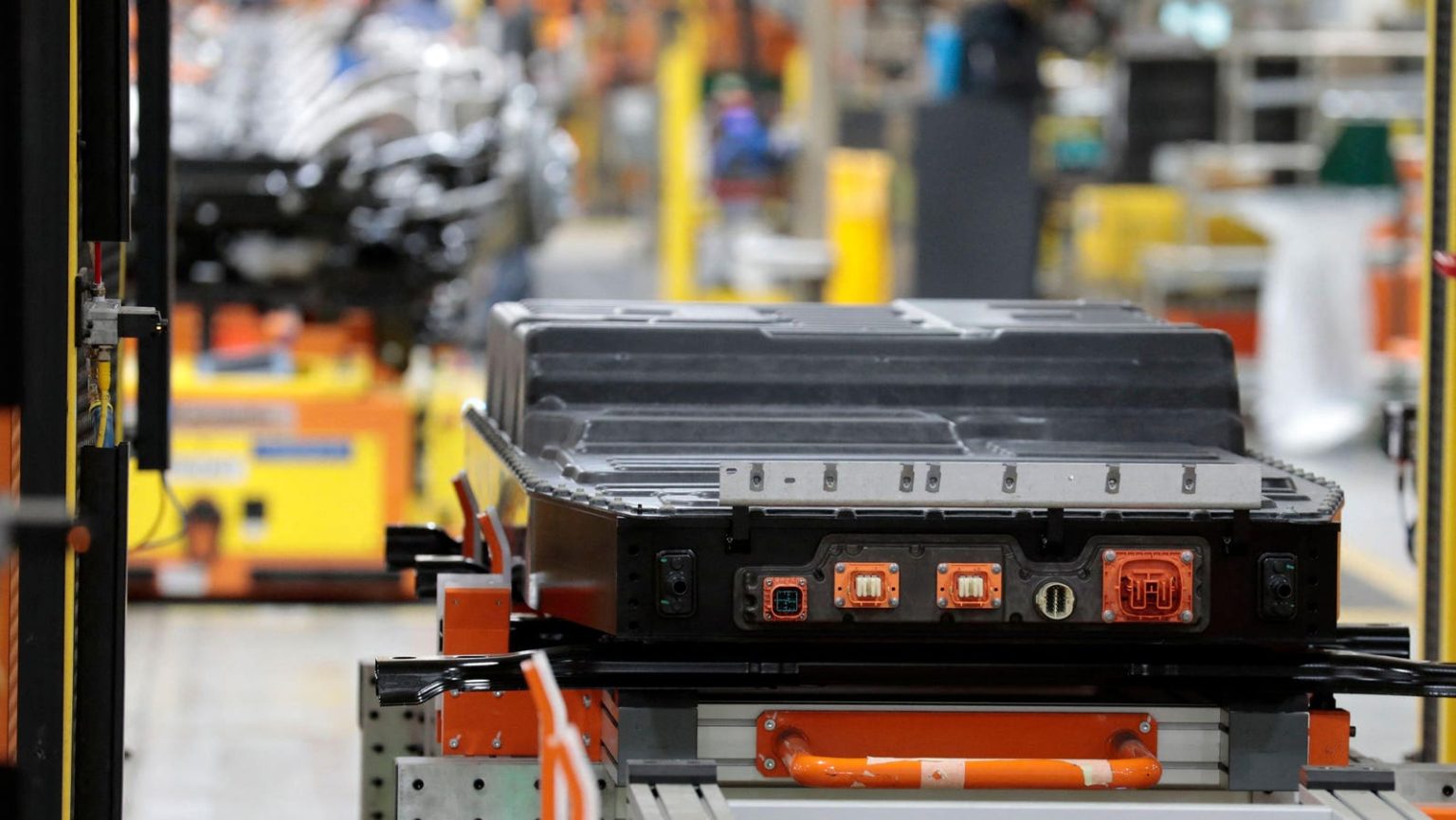While much of the limelight is on blue or green hydrogen produced from natural gas and renewable energy respectively, about a dozen energy and technology companies are quietly working to produce turquoise hydrogen whose byproduct could be critical to the electric vehicle market.
Turquoise, like blue hydrogen, relies on natural gas, but it uses a production pathway called methane pyrolysis.
Pyrolysis takes the natural gas—methane—molecule (CH4) and splits it into hydrogen and solid carbon.
The result is black gold, carbon powder that can be transformed into synthetic graphite, an increasingly lucrative critical mineral found in every single EV battery in the world.
“We all know the trajectory of lithium, and there’s more graphite in the battery than lithium,” said Nathan Ashcroft, Director for Hydrogen Solutions at Stantec, a design and engineering company based in Edmonton, Alberta.
“Aligning future industries with electric batteries and lithium, such as synthetic graphite and high value carbon, that’s where you really want to go,” Ashcroft said.
Besides, developing hydrogen from methane pyrolysis is more efficient, he added.
Ashcroft said he’s been studying and lecturing about the virtues of pyrolysis for years. “Green hydrogen and blue hydrogen are highly water intensive; it takes roughly 10 kilograms of water to produce one kilogram of blue or green hydrogen,” he said.
Water-stressed areas in the U.S, the desert Southwest, the Permian Basin, or parts of the world where there’s an abundance of natural gas and infrastructure but water is scarce, “those are the places that will be interesting for methane pyrolysis in the future,” Ashcroft said.
“Japan, Korea and China have jumped on this, and they have quite a bit of momentum in Asia around natural gas pyrolysis processes,” Ashcroft said. “It’s not going to be easy, but there’s value to be had in the carbon equation.”
The U.S. relies on graphite but does not produce any, natural or synthetic.
In 2021, 95 U.S. companies consumed 45,000 tons of natural graphite valued at $41 million, an increase of 41% in one year, according to the U.S. Geological Survey (USGS), the Interior Department’s science and statistical arm. Most of that came from China.
Meanwhile, one single large lithium-ion EV battery plant could require 35,200 tons/year of graphite for its anode material in the battery packs, according to USGS.
Natural graphite is cheaper to mine—$4,000 to $7,000 per ton. Synthetic graphite is upwards of $9,000 per ton. Graphite represents about 10% of the total cost of the cell.
“We’re going to see huge growth for graphite in North America all driven by the battery cell manufacturers who are primarily building for the auto sector, but also the energy storage sector,” said Novonix CEO, Chris Burns, PhD.
Australia-based Novonix is a battery materials and technology company planning to open the first U.S. commercial battery grade graphite facility by the end of 2024 in Chattanooga, Tennessee.
The company received $150 million grant from the U.S. Energy Department in October 2022 toward its $1 billion plant.
The China Factor
As the U.S. awaits its first synthetic graphite production plant, China still owns most of the world’s graphite.
China produces nearly 80% of total world output according to USGS. North America—Canada and Mexico—produces only 1.2% of global graphite.
That’s dwarfed by supplies coming out of the world’s top five producers—China, Brazil, Mozambique, Russia, and Madagascar.
“Every battery in every car in almost everything that’s practical that we’re talking about today, vehicles, energy storage, consumer electronics, almost all have graphite,” Burns said. “If you look at either natural or synthetic graphite, there’s only a handful of companies talking about trying to build here in North America.”
There will be more than 1 million tons/year of graphite demand by 2030 in North America alone, he said.
Meanwhile, “China controls the market,” Burns said. “They can control or throttle the growth outside of the Asian market if they control the upstream material,” he added.
“This tension between China and the U.S. is not going to lead to a stable supply chain,” Burns said.
On October 19, China’s Ministry of Commerce announced new export controls on battery grade graphite. Beginning December 1, U.S. companies will be required to apply for permits to receive synthetic and natural graphite from China, which has two-thirds of the world’s natural graphite supply.
U.S. companies already have the Section 301 tariff, a 25% tariff on incoming graphite from China, which will review the waiver extension in December.
Novonix will produce synthetic graphite globally.
For its Tennessee plant, Novonix will reconstruct petroleum coke from its largest shareholder, Phillips 66, into battery ready powder for cell manufacturers including LG Energy Solution, Panasonic, and Samsung SDI.
“When we buy petroleum-based coke products, we are almost upcycling those products into a cleaner ecosystem. If those were not distilled all the way down to the coking level, they would likely be sold off as fuel grade cokes or bunker oil for electricity,” Burns said.
Novonix said it could eventually move to alternative feedstock, such as solid carbon from pyrolysis or biomass to lower cost or carbon intensity of graphite, as a feedstock.
“The conversation is inherently complex. Would it be cleaner to go through pyrolysis to get that solid carbon, I assume the net result of the answer would be yes,” he said.
A Slim but Expanding Market
Fewer than a dozen small companies around the world are testing methane pyrolysis to produce turquoise hydrogen, but they have attracted millions of dollars from dozens of energy companies, including some majors, over the past two years.
The global hydrogen market is valued at about $170 billion this year, but it’s expected to expand to more than $300 billion by 2030 according to Grandview Research.
The $15 million turquoise hydrogen market alone is expected to grow to $144 billion by 2030 when many energy companies and government have pledged to go net-zero or meet global climate goals.
There’s only one commercial pyrolysis plant in the U.S., Monolith Nebraska LLC’s Olive Creek facility in Hallam, Nebraska. DOE guaranteed about $1 billion in loans for the facility which produces and sells hydrogen to make ammonia for agriculture. U.S. tire giants Michelin and Goodyear buy the carbon black byproduct.
Santa Monica, California-based C-Zero plans to be next and more efficient.
“What’s unique with our approach is not using large quantities of electricity, and we produce a little bit of water,” said Zach Jones, C-Zero’s chief executive and cofounder.
Blue and green hydrogen require water for production and green requires more energy to split the molecule.
“Thermodynamically it takes seven and a half times less energy to pull hydrogen off of carbon than it does to pull hydrogen off of oxygen,” Jones said. “We consume some of the product hydrogen we produce to drive the reaction forward so the only energy source you need to deploy our technology is natural gas, either a pipeline or a tanker full of LNG off the coast of Korea or Japan.”
C-Zero is focused on Korea, Japan, Southeast Asia, but also higher latitudes in North America and Europe.
“If it doesn’t work in Asia, it isn’t going to work anywhere. They don’t have anywhere to sequester CO2. The renewable capacity factor is not very good, and they have a strong societal will to pay a premium to decarbonize. That’s going to be the initial market for this,” Jones said.
Since launching in 2018, C-Zero has attracted investment from Breakthrough Energy Ventures, Eni Next, Mitsubishi Heavy Industries, AP Ventures, SK Gas, Engie New Ventures, and Trafigura.
DOE’s Office of Energy Efficiency and Renewable Energy’s Hydrogen and Fuel Cell Technologies Office awarded C-Zero $1 million in January 2020.
While the company’s pilot will be fully commissioned by the first quarter of 2024 and run through the year, Jones said he should also know where the company plans to put its first commercial pyrolysis facility by the second quarter of 2024.
He said he’d like to sell the commercial operation to “any entity that is involved in the natural gas value chain, producer, distributor, consumer with a big balance sheet and a history of developing chemical processes, a company who can help with engineering and scaleup.”
There are still hurdles to pyrolysis.
“The challenge that any methane pyrolysis process has is you’re throwing away half the energy in the natural gas in the form of solid carbon,” Jones said.
Translation: It takes twice as much natural gas to produce the same amount of energy.
“If you have really dirty upstream methane emissions and you’re running those into a process where you need twice as much natural gas, those upstream methane emissions can bite you twice, whereas they only bite blue hydrogen once,” Jones said.
Jones said his hope is that natural gas is going to be cleaned up from an upstream methane emission perspective.
“It’s not a glamourous process. You’re still connected to fossil fuels. You’ve got giant piles of carbon you have to put back in the ground. You’re throwing away half the energy of natural gas, so it doesn’t really fit into anybody’s sweet spot. It doesn’t look great from a PR perspective,” Jones said.
It’s why start-up technology companies rather than oil and gas majors are driving pyrolysis, he said.
“We feel like we’re in the right place at the right time with the right idea,” Jones said.
American Petroleum Institute’s vice president of Natural Gas Markets, Rob Jennings, said “approximately 30 API member companies have invested in hydrogen technologies along the whole value chain.”
Those who are involved in pyrolysis are largely keeping a low profile.
ExxonMobil is testing the commercial viability of methane pyrolysis in Korea and plans to unveil a demonstration project within a year according to several sources familiar with that project. Beyond that, crickets.
“The carbon sink world is alien to U.S. majors, whereas in Asia, they are “integrated value-driven companies and technology driven companies,” Ashcroft said.
“Monetizing carbon for ExxonMobil, Chevron, others, that’s never going to become part of their core business,” he added. “I don’t expect ExxonMobil to go into the synthetic graphite refining industry, but they will make a handsome amount of money from selling this feedstock.”
Hydrogen + EVs = Biden’s Energy Policy
While hydrogen production and electric vehicle expansion are central to President Biden’s energy policy, the administration, which is infusing billions of dollars into both, is not linking the two.
This month, the White House and the Department of Energy announced $7 billion to advance seven U.S. Regional Clean Hydrogen Hubs (H2Hubs) to “accelerate the commercial-scale deployment of low-cost, clean hydrogen.”
About two-thirds of the money will advance green hydrogen projects, those produced from renewable energy. The other third will be blue hydrogen projects using a process called steam methane reforming which splits the molecule into hydrogen and carbon dioxide gas and sequesters the CO2 underground.
No mention of methane pyrolysis in President Biden’s announcement.
The Department of Energy told Forbes that it has not yet determined whether methane pyrolysis is “clean.”
It must first examine the lifecycle emissions “well-to-gate” of methane pyrolysis, which is ongoing as the Treasury Department prepares to issue regulations about how it will dole out hydrogen production incentives outlined in the celebrated Inflation Reduction Act.
DOE factors in upstream emissions from the feedstock, which in this case, is natural gas. It examines emissions at the production facility itself.
“Therefore, the question of whether H2 produced from methane pyrolysis is considered ‘clean’ will depend on the potential emissions from other parts of the lifecycle,” DOE said.
Read the full article here





